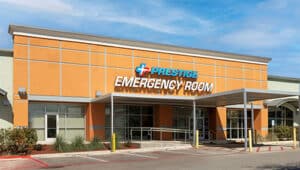Sepsis is a life-threatening emergency that can develop quickly and silently.
Recognizing the signs of sepsis early and seeking prompt emergency room care can save your life or the life of someone you love.
At Prestige Emergency Room in Texas, we’re open 24/7 and equipped to respond immediately to sepsis emergencies with expert care.
What is Sepsis and Why is It Dangerous?
Sepsis happens when your body has an extreme and uncontrolled reaction to an infection.
Typically, the immune system defends the body by attacking harmful bacteria, viruses, or fungi. But in sepsis, the body’s immune response becomes dangerously overactive. Instead of fighting the infection, it begins attacking the body’s tissues and vital organs.
This widespread inflammation can cause blood clots, leaky blood vessels, and impaired blood flow, all of which prevent oxygen and nutrients from reaching crucial organs like the brain, heart, kidneys, and liver. When tissues are deprived of oxygen due to sepsis, vital organ systems rapidly deteriorate, triggering the warning signs of sepsis that require emergency intervention.
Early signs of sepsis, like fever, weakness, or confusion, can look like many less serious illnesses. Sepsis is often called “the silent killer.” It can progress rapidly, especially in vulnerable individuals, and many people don’t realize they are critically ill until it’s almost too late.
Early Signs of Sepsis Everyone Should Know
Here’s how to spot the initial symptoms of sepsis using the easy-to-remember S-E-P-S-I-S guide:
- S – Slurred Speech or Confusion: Difficulty speaking clearly or sudden mental confusion can signal that the infection is affecting brain function.
- E – Extreme Pain or Discomfort: People with sepsis often describe feeling the worst pain or discomfort they’ve ever experienced.
- P – Pale or Discolored Skin: Skin may appear unusually pale, mottled, ashen, or bluish, especially around the lips, hands, and feet.
- S – Sleepy, Difficult to Wake: If a person becomes unusually sleepy, lethargic, or hard to wake, it’s a critical red flag.
- I – “I Feel Like I Might Die”: A sense of impending doom or feeling intensely unwell is a common, urgent symptom reported by sepsis patients.
- S – Shortness of Breath: Difficulty breathing, rapid breathing, or feeling like you can’t catch your breath can mean the infection severely affects the lungs.
If you or someone else experiences any of these symptoms, don’t wait; visit a Prestige ER near you immediately.
Recognizing Sepsis Symptoms by Severity
Sepsis symptoms can worsen quickly, moving from mild warning signs to severe, life-threatening complications.
Understanding how symptoms progress can help you recognize when immediate emergency services are needed.
Early Sepsis: The First Warning Signs
In the early stages, sepsis may resemble a typical infection or flu.
Be alert for these initial symptoms, which often signal the beginning of a dangerous response:
- Fever, chills, or very low body temperature.
- Rapid heart rate.
- Fast breathing.
- Extreme weakness or fatigue.
If sepsis is identified and treated quickly, full recovery is often possible at this stage.
Severe Sepsis: When Organ Function Is Affected
As sepsis progresses, it can begin to impair vital organ function.
These symptoms indicate the infection is becoming much more serious and requires urgent emergency room evaluation:
- Difficulty breathing.
- Reduced urine output, signaling potential kidney involvement – a critical sepsis warning sign.
- Sudden mental confusion.
- Signs of organ dysfunction (such as jaundice or abnormal heart rhythms).
Severe sepsis is life-threatening and demands rapid treatment to prevent irreversible damage.
Septic Shock: Critical Warning Signs
If sepsis is not treated promptly, it can escalate to septic shock, a critical condition with an extremely high risk of death.
Watch for these signs of severe emergency:
- Very low blood pressure that doesn’t improve with fluids.
- Severe difficulty breathing.
- Cold, clammy skin.
- Loss of consciousness.
Septic shock is a true medical emergency that requires immediate, advanced care in an emergency room. With sepsis symptoms, immediate emergency treatment is essential – delayed care dramatically reduces survival rates in septic patients.
High-Risk Groups: Who’s Most Vulnerable to Sepsis
While sepsis can affect anyone, certain groups are at higher risk, including:
- Adults 65 years and older.
- Infants and young children.
- People with weakened immune systems.
- Patients with chronic illnesses like diabetes, cancer, or kidney disease.
- Individuals recovering from recent surgery, infection, or hospitalization.
Knowing whether you or a loved one falls into a high-risk group can help you stay extra alert to sepsis symptoms.
When to Go to the ER for Sepsis
Sepsis is a medical emergency that worsens rapidly. Please do not wait for symptoms to improve on their own.
You should go to the ER right away if:
- You or a loved one shows signs of infection alongside symptoms like fever, confusion, or shortness of breath.
- Symptoms are getting worse quickly or seem unusual or extreme.
- You have risk factors like a recent infection, surgery, a weakened immune system, or a chronic illness.
Early action can mean the difference between full recovery and life-threatening complications.
Beyond the ER: Sepsis Recovery and Follow-Up Care
Understanding what to expect after sepsis can help patients and families prepare for the journey ahead.
Common aspects of sepsis recovery may include:
- Physical therapy to rebuild strength and endurance.
- Rehabilitation therapy to help recover abilities for daily living after experiencing sepsis symptoms.
- Speech-language therapy if communication or swallowing were affected.
- Medication management to control risk factors like blood pressure or blood sugar.
- Mental health support for anxiety, depression, or memory challenges that can follow a sepsis event.
Regular follow-up care is essential to monitor your recovery, manage any lasting effects, and reduce the risk of future infections.
With the proper medical care and support system, many sepsis survivors can return to active, fulfilling lives.
Preventing Sepsis: Reducing Your Risk
The best way to fight sepsis is to prevent infections from happening or worsening.
Here’s how:
- Keep wounds clean and properly bandaged.
- Stay up to date on recommended vaccines.
- Practice good hand hygiene by washing hands often to prevent infections that could lead to sepsis symptoms.
- Manage chronic conditions carefully with regular medical care.
- Seek medical attention quickly for any signs of infection (like fever, swelling, redness, or worsening pain).
Simple steps can make a big difference in protecting yourself and your family.
Visit Prestige ER for Sepsis Emergencies in San Antonio
If you suspect sepsis, every second counts.
At Prestige Emergency Room, we’re ready 24 hours a day, 7 days a week, to provide immediate, expert care for sepsis emergencies and other life-threatening conditions throughout San Antonio.
In a life-threatening emergency, trust Prestige ER to act fast, treat expertly, and save lives.
For immediate sepsis emergency treatment, locate your nearest Prestige ER to receive life-saving care when warning signs appear.












